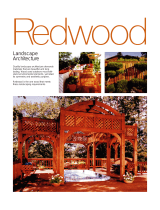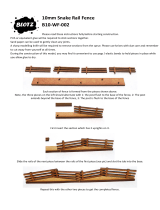
Build
and
hang
the gate
There’s something deeply
satisfying about a gate that opens
easily, swings freely, and closes
securely with a reassuring click.
Building such a gate requires you
Fig. 11:
GATE FRAME
&
BRACE
Test
for
square
corners
Latch
side
2 x
4
brace
Hinge
Fig. 12:
HINGES AND
LA
TCHES
Ornamental
T-Hinge
to exercise care and craftsmanship
in each of the five steps of gate
construction: setting the gate posts,
2 x 4
gate
frame
side
Strapped
H-Hinge
building the frame, adding fencing
boards, hanging the gate and
installing the latch.
Gate posts should be set deeper
than your fence line posts—about
1/3 their total length—and anchored
in concrete. This is necessary
because of the need to withstand
additional stresses. Posts also must
be carefully plumbed so that their
inside faces are exactly parallel.
Fig. 10:
GATE ELE
VATION
4 x
4 posts
and fence
1
/
4
"
-
3
/
4
"
space
When measuring the opening,
make sure to allow for clearances on
the hinge and latch sides of the gates
(Fig. 10). For gates with standard
2x4 framing and 4x4 posts, leave a
1/2- to 3/4-inch space between the
latch post and the gate frame. On
the hinge side, it will depend on the
hardware you use. About 1/4 inch is
usually sufficient.
Once the posts are set, begin
assembling the frame (Fig. 11). Cut
the pieces to length and assemble
them on a flat surface, making
Oppostie sides are parallel when
diagonals
are
of
equal
length.
certain that the gate frame is in
square. Use a carpenter’s square to
check the corners and then measure
the diagonals. When the diagonals
are equal, the sides of your gate are
parallel and the frame forms a true
rectangle. Use wood screws and a
good exterior wood glue instead of
nails for added strength.
To measure the brace, lay the
frame down on top of the 2x4
bracing member and mark your cut
lines. The easiest cut is a single,
angled cut so that the brace will run
from hinge side bottom to latch side
top. Cut the 2x4 just outside your
marks so the brace will have a tight
fit, and attach the brace to the frame
with nails or screws.
Now add the boards, starting
from the side where the hinge will
go. If the last piece is not flush with
the frame edge, either space the
boards slightly or plane a little from
each board until they fit. Then drill
your pilot holes and fasten the
hinges to the gate. There are a large
variety of hinges and latches to
choose from. (Fig. 12 shows the
most common.)
At this point you’re ready to
hang the gate, but before you do
anything, you’ll want to check the
fit by moving the gate in position
and trimming any areas that are too
tight to provide ample clearance.
Now prop the fitted gate into the
opening using blocks to support it,
or have a helper hold it in position,
and mark the hinge and screw hole
positions on the post. Once the
holes are drilled, replace the gate,
Ring
Latch
Top
Latch
and attach the hinges to the post.
Finally, mount the latch assembly
on the gate and post, using screws a
little longer than usual to help the
latch withstand the punishment it
will take through years of use.
Finally, it’s time to congratulate
yourself on a job well done.
Fig. 13: HANG THE
G
A
TE
Latch
side
bears load
2 x
4
braces from
hinge
bottom
to
latch
top
2 x
4
frame
Minimum depth
of
gate
post hole should
equal 1/3 the
overall
post
length
15















